Klue Compete
The Competitive Enablement Platform
Learn More
FIND OUT MORE >

Building out an all-star competitive enablement program isn’t easy.
Especially if you’re an army of one.
Oftentimes, being in charge of competitive enablement at your company is one of the many hats that you’re wearing. So, how do you go about running a competitive enablement program that is efficient and helps the business?
It comes down to possessing three critical skillsets. In our recent webinar, Scot Kim, Global Competitive Intelligence leader at Conga and former analyst at Gartner, joined us to detail how these skillsets fit into building the dream competitive enablement team.
If you have the good fortune of running a competitive program with multiple people, then great! These roles could be assigned to different individuals.
But, if you’re running competitive intelligence solo and need to be as efficient as possible, then these are the three key areas you should focus on.
In order to gather the best competitive intelligence possible, you need to have a researcher’s mentality. You need to be able to flip over every rock, look into every single piece of data, and understand where it leads to.
Although the juiciest nuggets of competitive intelligence tend to come from internal teams, even the most innocuous bits of information on external websites can lead to insights on a competitor when you adopt that researcher’s mentality.
One of the most important parts of the researcher role is being able to triangulate competitive data for credibility. Simply put, your information needs to be correct.
Relying on just one source and then sharing that information across the company?
That ain’t gonna cut it.
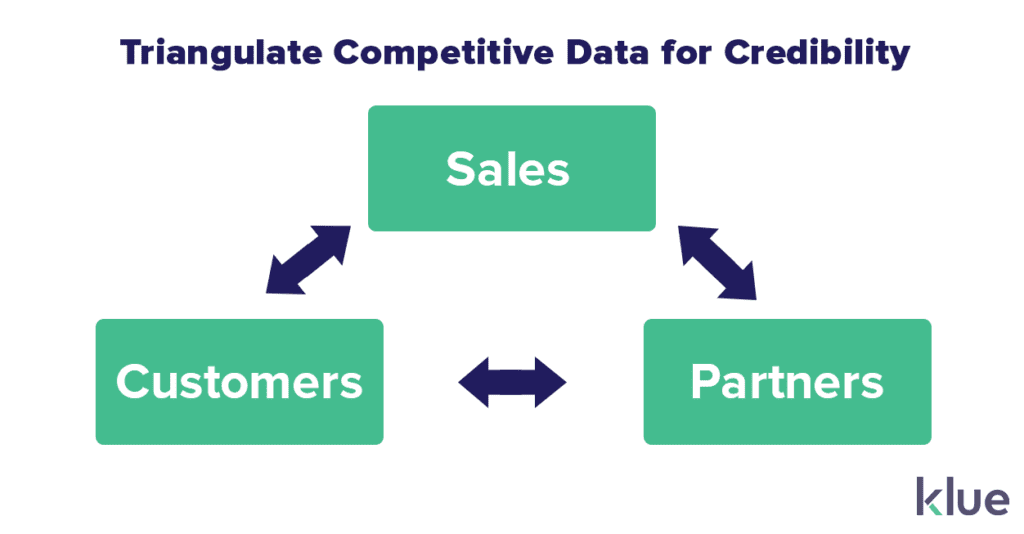

By having a process in place in which you triangulate data between what the sales team are hearing, what customers are saying, and briefings from partners, you’ve established a stronger vetting process that will ultimately give you more confidence in the insights that stand up across those channels.
However, this triangulation can break down in two different scenarios:
In the COVID-enforced remote workplace, the ability to have those ‘water cooler’ conversations are no more. It’s far more difficult to get a pulse on what teams are hearing and saying when you can’t pick up on those day-to-day conversations.
That’s why competitive enablement programs have to now be overly communicative in the ‘new normal’. You have to proactively set up Zoom meetings, and go out of your way to build relationships with employees that you haven’t met before.
On a call with a salesperson talking about competitor messaging that is popping up in their calls with prospects? Get them to refer you to another person that’s also experiencing this – maybe on the customer service side or another salesperson – to grow out your network.
An underreported ability that’s critical for competitive intelligence leaders is taking copious amounts of notes.
Some weeks you may be talking to over fifty people. That’s a lot of conversations. It’s common to get these conversations you had mixed up, especially if you don’t take detailed and organized notes.
Make sure that you are noting what competitive information you are hearing, who you’re hearing it from, and when you’re hearing it. If you want to triangulate insights well, then taking detailed notes in every conversation will go a long way.
Ensuring credibility is the first piece of the competitive puzzle for researchers. Next, you’ve got to put the data into a format that is easily consumable for your teams.
Building out a competitive matrix or a scorecard presents a high-level overview of the competitive landscape. These are strategically driven formats that can help with newcomers learning the industry, or serve executive teams that need a broader picture.
However, the best way to share competitive information that teams can use in the trenches is through competitive battlecards.
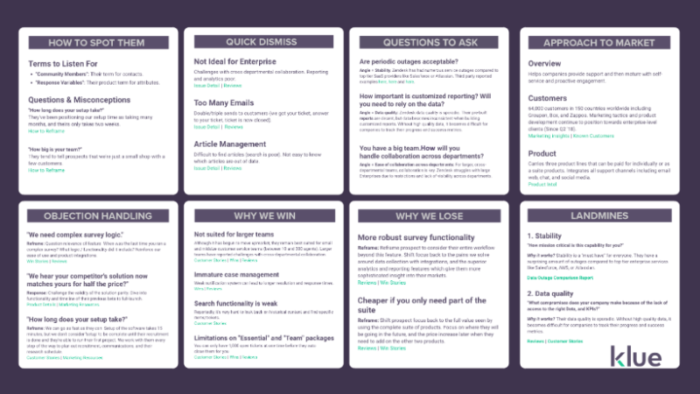

So, what makes the best battlecard possible? Containing the absolute minimum amount of content needed to enable your teams. Be it sales converting a prospect, growing an existing account, or tightening the messaging that brings in qualified leads.
Learn how you can build out competitive battlecards that arm your team with everything they need to stay ahead of the competition here.
The strongest competitive enablement teams don’t work in a silo. Although they’re tasked with the creation of competitive collateral, the burden for gathering insights shouldn’t fall entirely on their shoulders.
That’s why having a collaborator skillset is crucial.
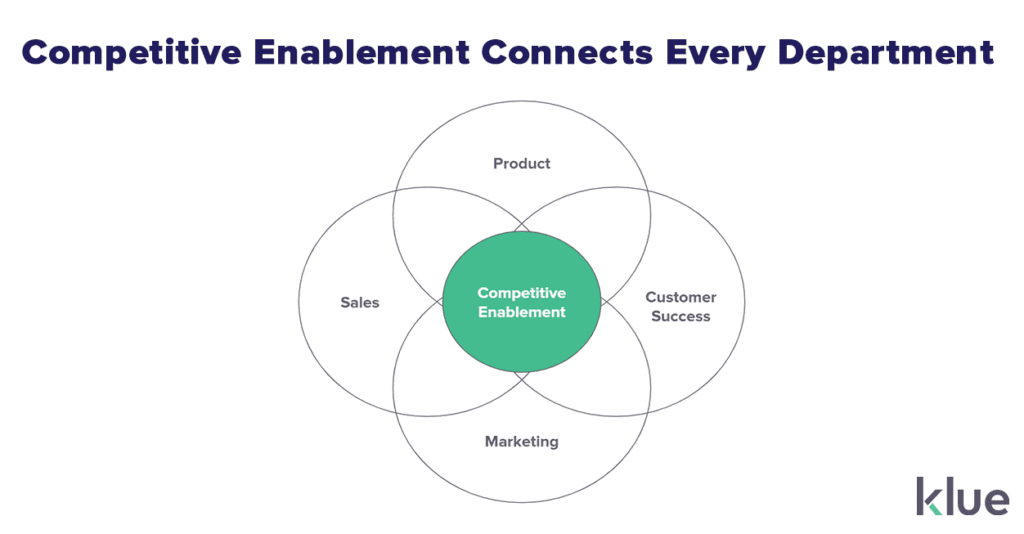

Ultimately, competitive enablement is a two-way street.
Building a competitive intelligence community within your company in which employees sharing what they hear is just second-nature, has two distinct benefits:
Many hands make light work. If you’re a competitive enablement team of one, then tapping into this communal aspect of sharing insights is critical.
That sales call your Account Executive just had with a prospect who spilled the beans on a competitor’s pricing model? That’s information that needs to be shared across the organization.
The competitor messaging that a client is constantly using during renewal discussions? Share it!
Your product team learns about new integrations your competitor is rolling out this quarter? Yep, you get the idea.
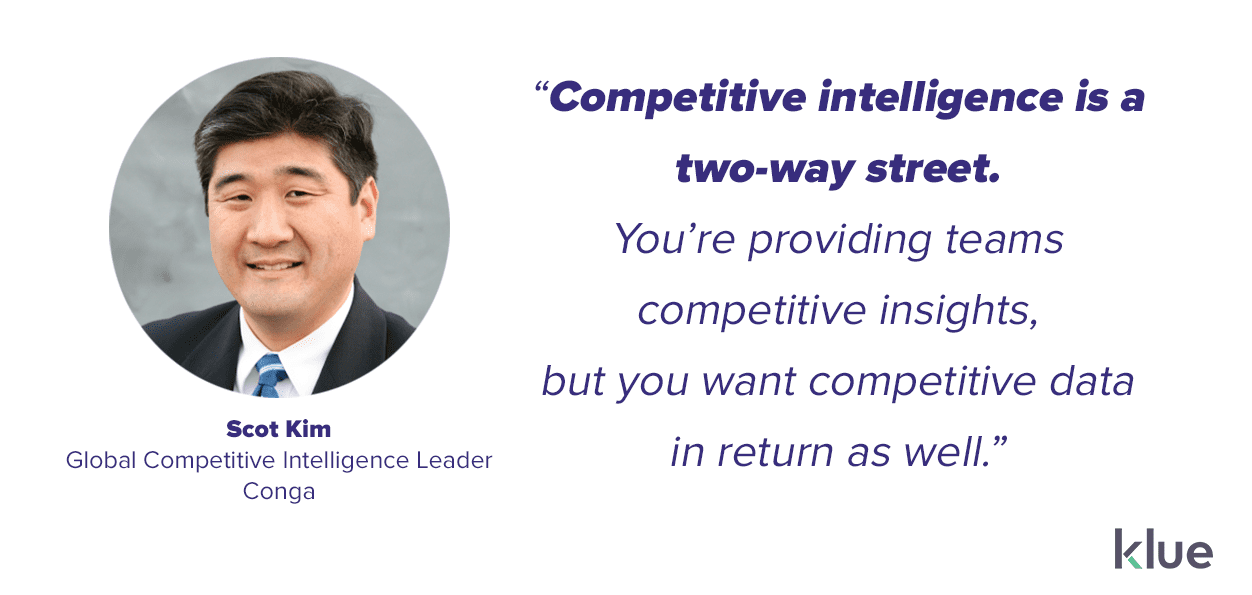

One of the best ways to get visibility across your company is to brand competitive enablement. Scot shares three methods he’s used to brand his competitive programs:
Kick-off the year by getting in front of your sales team at SKO.
You’re not going to be able to dump every bit of information on competitors, the landmines sales need to lay, and the messaging they need to adopt in thirty minutes. Nor will sales be able to absorb even a quarter of that information you’ve word vomited.
Instead, sell to your sellers. Pitch them on the competitive intelligence community you’re building, share data that shows the importance of your program to them, and be clear and concise on the competitive takeaways you want them to remember.
Let them know about timing, expectations, and what else is going to happen with your program after SKO.
Getting thirty minutes with the sales team at kick-off time? Well, that’s gold!
The SKO is your hook to build interest. Now it is time to follow through.
Set up regular meetings where you can dive into the information that you’ve teased at the start of the year. Although the remote workplace isn’t ideal, a simple tactic that often gets overlooked is to keep your video on during these Zoom calls. Attach a face to your competitive enablement program!
Let your work do the talking during these regular meetings. This is your time to let the hard-work you’ve put into creating relevant, digestible insights, shine. If you do great work, people will gravitate towards the competitive intelligence that you provide.
If you have a detailed win-loss analysis that pinpoints where deals are being won and lost… people will want to know these results.
If you have quantitative data that explains why clients have left a competitor and bought your product or service… guess what? People are going to want to know the results.
Don’t rely on people taking scrupulous notes during your presentations. Make it as easy as possible to consume your intel with newsletters that recap what different teams need to know, and why.
Newsletters shouldn’t be your sole method of communication, but it is another opportunity to remain at the top of mind amongst the company.
Frankly, the competitive intelligence you distribute needs to be easy.
Easy on the eyes. Easy to consume. And easy to use.
The ability to craft a strong but concise narrative is the best way to get your revenue teams to use the insights that you’ve uncovered. Share what the situation is, what it’s impact on the business is, and what needs to be done to resolve it.
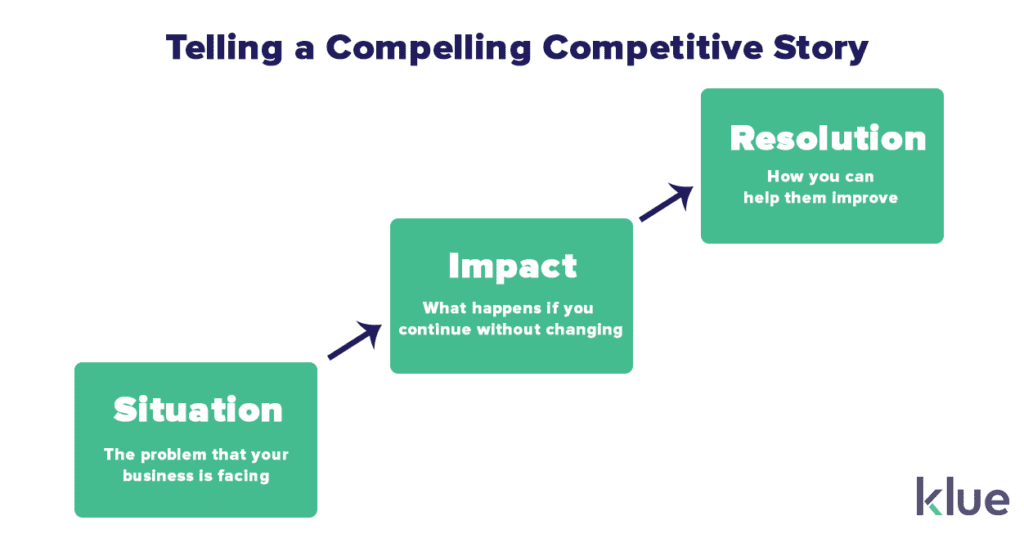

Although being a storyteller requires presenting this captivating narrative, it isn’t about spinning the truth. You’re not hired to be the company hype-person.
Competitive enablement teams are there to be the truth-tellers.
You have to be comfortable pointing out where the business is struggling, why sales are losing deals, how messaging is landing, and providing quantitative data to back this up.


Clearly stating the competitive situation and its impact without sugarcoating is only part of the deal. It’s time to present a solution.
This is the key to competitive. Formulating a narrative that leverages your strengths and hits your competitor’s weaknesses.
Scot experienced an example where he had to quickly tell a compelling story in order to enable his sales team. A competitor rolled out a new product that functioned really well.
Okay. Problem identified.
But, we’re talking about stealing-your-current-customers levels of well.
Scot presented the stakes. We’re going to lose clients if we don’t address this? Impact established.
However, that particular function only worked well for a very particular customer base. Yet, the competitor’s messaging was “hey, everyone can use this!”.
Boom. There’s the solution.
Scot depositioned the competitor by leveraging this incorrect messaging they used. While conceding that they’ve nailed serving a niche audience, he enabled his sales team by focusing on the fact that his company’s product was far stronger at serving across numerous different verticals.
Quickly nailing this message mitigated the threat posed by a competitor without having to tell lies, or resort to the knee-jerk price slashing.
Competitive enablement teams aren’t always blessed with infinite sums of money or headcount. Sometimes you’ve got to get creative, and be as efficient as possible in the process.
Having these three skillsets covered is the best way to maximize your competitive enablement efforts, even if you’re an army of one.


Competitive Enablement
The topic of Large Language Models (LLMs) has a lot of confusion. Here's what you need to know about how Klue is working with them.


Competitive Enablement
Product Marketing
If your competitive intel game is too strong for automation, too pure for data privacy, and too rebellious for accuracy — then Klue AI is probably not for you.


Let’s do it. Tell us a bit about yourself and we’ll set up a time to wow you.
Let's do it. Tell us a bit about yourself and we'll set up a time to wow you.
XLet's do it. Tell us a bit about yourself and we'll set up a time to wow you.
XSubscribe to get our latest AI functionality and news in your inbox.
XOur Buyer Pulse feature, set to launch in Q2 2024, offers valuable insights into the factors influencing buyer decisions in your pipeline. By signing up for the waitlist, we can better gauge interest and proactively engage with you to streamline the setup and integration process before the feature becomes widely available.
X